Introduction
In the ever-evolving landscape of data analytics, organizations are continually seeking innovative solutions to enhance their reporting capabilities and drive informed decision-making. Power BI Premium emerges as a powerful ally, offering a suite of advanced features designed to tackle common challenges such as time-consuming report creation and data inconsistencies. From improved performance and larger data capacity to integrated AI functionalities, Power BI Premium equips businesses with the tools necessary to navigate complex data environments with confidence.
As organizations embark on the journey to transition to this robust platform, understanding the key features, licensing options, and best practices becomes essential. This article delves into the transformative impact of Power BI Premium, providing a comprehensive guide to maximizing its potential and ensuring a seamless transition that empowers teams to harness actionable insights for strategic growth.
Understanding Power BI Premium: Key Features and Benefits
The premium capacity Power BI offers a robust suite of advanced features that significantly improve analytics capabilities for organizations, addressing common challenges encountered in reporting. The key benefits include:
- Enhanced Performance: By leveraging dedicated cloud resources, users can experience notably faster data refresh rates, leading to improved report performance that meets the demands of dynamic business environments.
- Premium Capacity Power BI: This edition allows for managing larger datasets, facilitating comprehensive analysis without the limitations often encountered in standard versions.
- Advanced AI Features: Integrated AI functionalities, such as Small Language Models and GenAI Workshops, empower users to extract meaningful insights from their information, improving information quality and training capabilities for informed decision-making processes using premium capacity Power BI.
- 3-Day Power BI Sprint: This feature enables organizations to quickly create professionally designed reports, streamlining the reporting process and allowing teams to focus on leveraging insights rather than constructing reports.
- General Management App: This comprehensive management tool aids in smart reviews and actions portfolio, ensuring that organizations can effectively manage their reporting processes.
- Paginated Reports: The ability to create pixel-perfect reports ensures that organizations can produce high-quality outputs tailored for printing and sharing, enhancing the communication of insights.
- Dataflows: These enable streamlined information preparation processes, leading to improved management and consistency across reporting and analytics workflows.
It is important to note that while calculated columns can increase model size and memory consumption, measures can impact query performance but offer flexibility for dynamic reporting. As Amitabh Saxena mentioned on October 23, 2024, “Business Intelligence upgrades enable organizations to traverse intricate information environments with ease and accuracy.”
Additionally, the VertiPaq Engine serves as a powerful example of how premium capacity Power BI’s features contribute to efficiency and performance. As an in-memory columnar database, it processes DAX expressions and manages operations such as aggregations and filtering, significantly reducing memory usage and enhancing query performance. Getting acquainted with these features is essential, as they signify a significant advancement from standard BI capabilities to premium capacity Power BI.
Organizations that embrace BI can anticipate enhancing their information strategies, thus gaining substantial advantages in their analytics efforts, while addressing the difficulties of labor-intensive report generation and ensuring practical guidance in their insights. This visual metaphor of a human figure contemplating a question alongside a robot symbolizing solutions perfectly illustrates the collaborative potential of AI and human intelligence in enhancing data-driven decision-making.
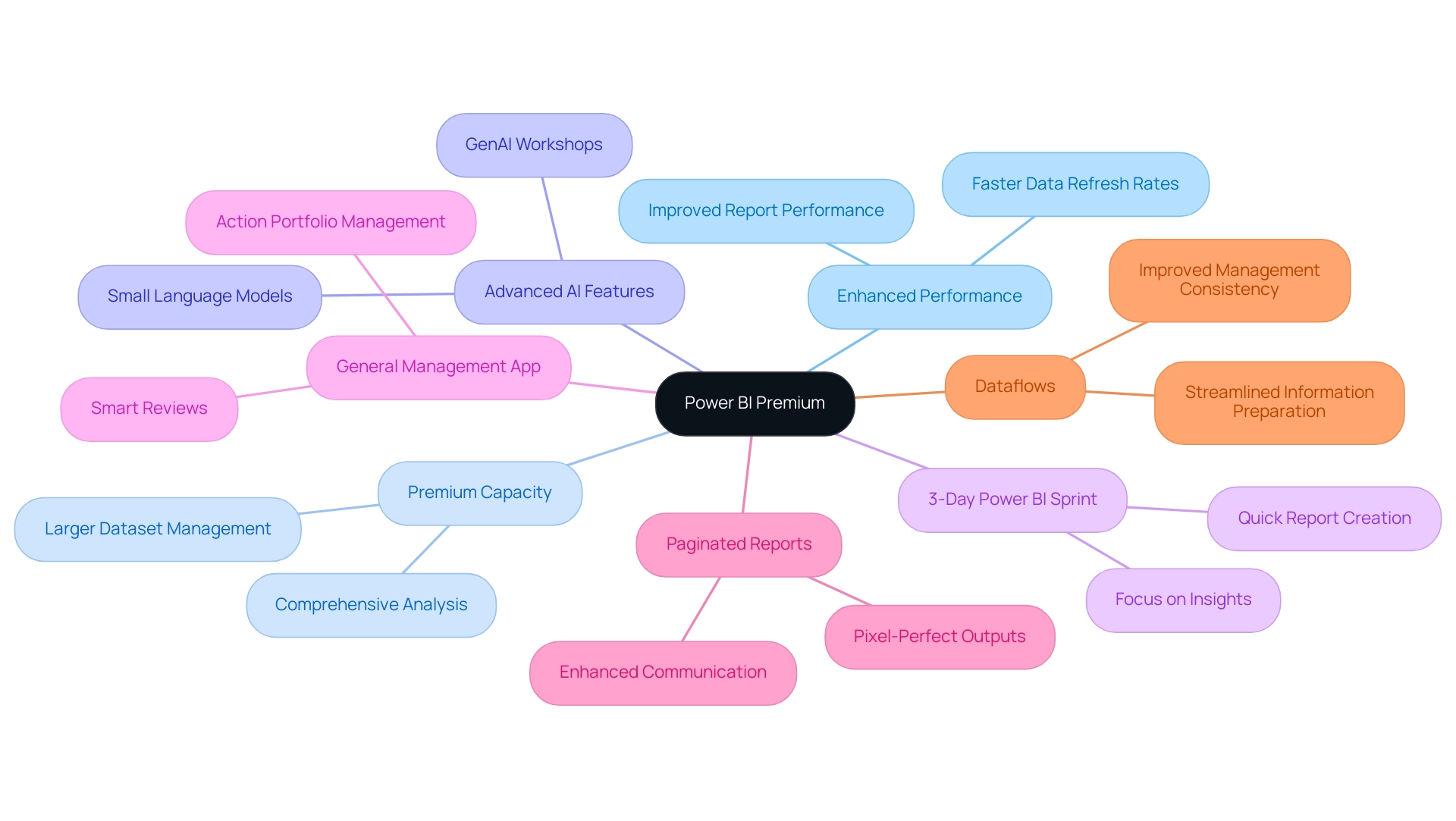
Step-by-Step Guide to Transitioning to Power BI Premium Capacity
Shifting to BI Enhanced capacity can significantly improve your organization’s analytical abilities, especially in tackling typical challenges encountered in utilizing insights from BI dashboards, such as time-consuming report generation and data discrepancies. Here’s a step-by-step approach to ensure a seamless migration:
- Assess Your Current Environment: Begin by evaluating your existing BI setup. This assessment is crucial to identify whether the advanced features of the higher-tier option are necessary for your operations.
- Choose the Right Licensing Option: Review your organization’s specific needs. Choosing the suitable BI plan is crucial, particularly with the impending end of BI SKUs after January 1, 2025. As industry expert Charlie Phipps-Bennett states, “Business Intelligence SKUs will no longer be available after January 1, 2025,” emphasizing the urgency to make this decision promptly.
- Create a High-Quality Workspace: In the Power BI service, establish a new workspace and assign it to enhanced capacity. This workspace will be vital for utilizing the full advantages of enhanced features, including thorough management and smooth information integration.
- Migrate Reports and Datasets: Carefully transfer your existing reports and collections to the new enhanced workspace, ensuring compatibility of all sources. This step is critical to maintain continuity in reporting and to avoid inconsistencies that can lead to confusion and mistrust.
- Set Up Dataflows: Implement workflows to enhance preparation processes and improve quality within the workspace. This practice streamlines operations and optimizes performance, addressing task repetition fatigue effectively.
- Test and Validate: Before complete deployment, perform comprehensive testing of the workspace’s performance and features. This validation will help uncover any potential issues, ensuring a smooth transition. Consider reviewing utilization data to understand if requests were throttled due to capacity issues, which may necessitate autoscaling in the future.
- Train Your Team: Invest in training for your team on the new features available in BI, including predictive analytics and Microsoft Copilot integration. Empowering your staff with knowledge is key to maximizing the benefits of this upgrade.
By adhering to these steps, your organization can effectively transition to premium capacity Power BI, which will unlock enhanced performance and analytics capabilities while preparing for future improvements. Moreover, recent information indicates that your metrics report dataset can retain valuable insights for 30 to 45 days, aiding in monitoring the transition’s success. This guide is part of a comprehensive resource published on November 29, 2024, ensuring you have the latest information at your disposal.
Additionally, integrating RPA solutions can further alleviate the burden of repetitive tasks, enhancing overall operational efficiency and allowing your team to focus on deriving actionable insights from the data.
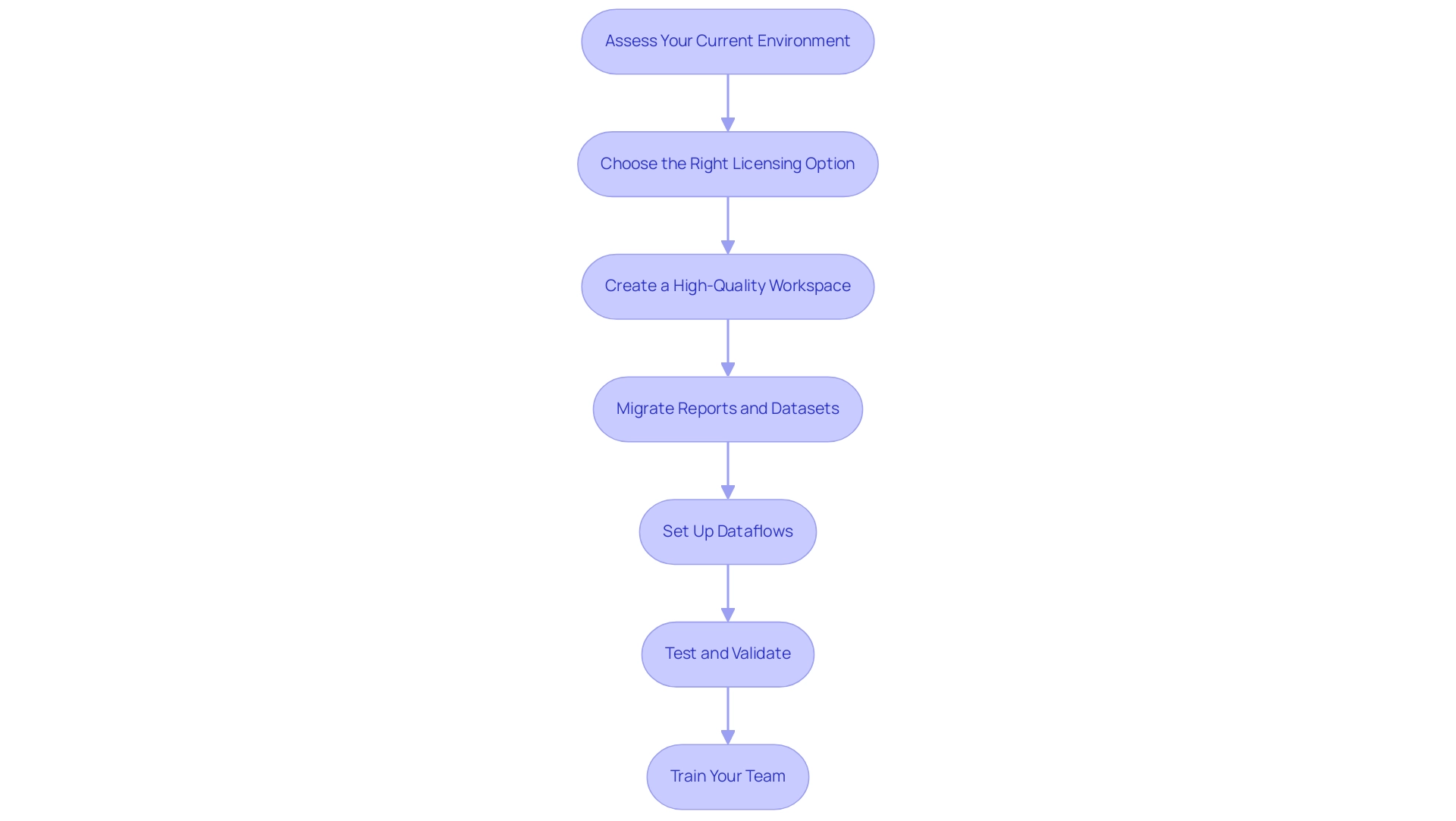
Navigating Power BI Licensing: Choosing the Right Plan for Your Needs
Power BI presents a variety of licensing options tailored to meet the needs of different users and organizations:
- Power BI Pro: This plan is designed for individual users or small teams who require essential collaboration and sharing capabilities.
- BI Enhanced Per Individual (EPI): For individuals requiring advanced features and functionalities on a per-individual basis, the EPI option is ideal and costs 18.70 € per individual each month.
- Premium Capacity Power BI: This option is most suitable for larger organizations that require dedicated resources and superior performance.
When selecting the right plan, consider several critical factors that can directly influence your operational efficiency and data-driven insights:
- The number of users requiring access to Power BI tools.
- The size and complexity of your datasets, as these can impact performance.
- The specific features your organization depends on to drive business objectives.
Organizations often face challenges with BI, such as time-consuming report creation, data inconsistencies, and difficulties in extracting actionable insights. These issues can hinder effective decision-making and limit the potential of Business Intelligence. Expert insights can further inform your decision.
As Julien Guillot from Schneider Electric states, “TTMS has really helped us through the years in the field of configuration and management of protection relays with the use of various technologies.” This underscores the importance of choosing a plan that aligns with your operational needs and leverages the full potential of Business Intelligence.
Additionally, a recent case study titled “Pages Included in the Improved Usage Metrics Report” showcases how the enhanced usage metrics report features several pages, including report usage, report performance, and an FAQ section. These pages provide comprehensive insights into report views, performance metrics, and answers to common questions, enhancing user understanding and engagement.
It’s also important to be aware of current challenges; customers may face issues viewing or downloading the usage metrics semantic model from the BI service. By thoroughly evaluating these elements, your organization positions itself to select the most fitting licensing option for premium capacity Power BI, ensuring that your BI experience is both effective and efficient. Integrating RPA solutions can also streamline processes, reduce repetitive tasks, and enhance overall operational efficiency, aligning with your broader organizational goals.
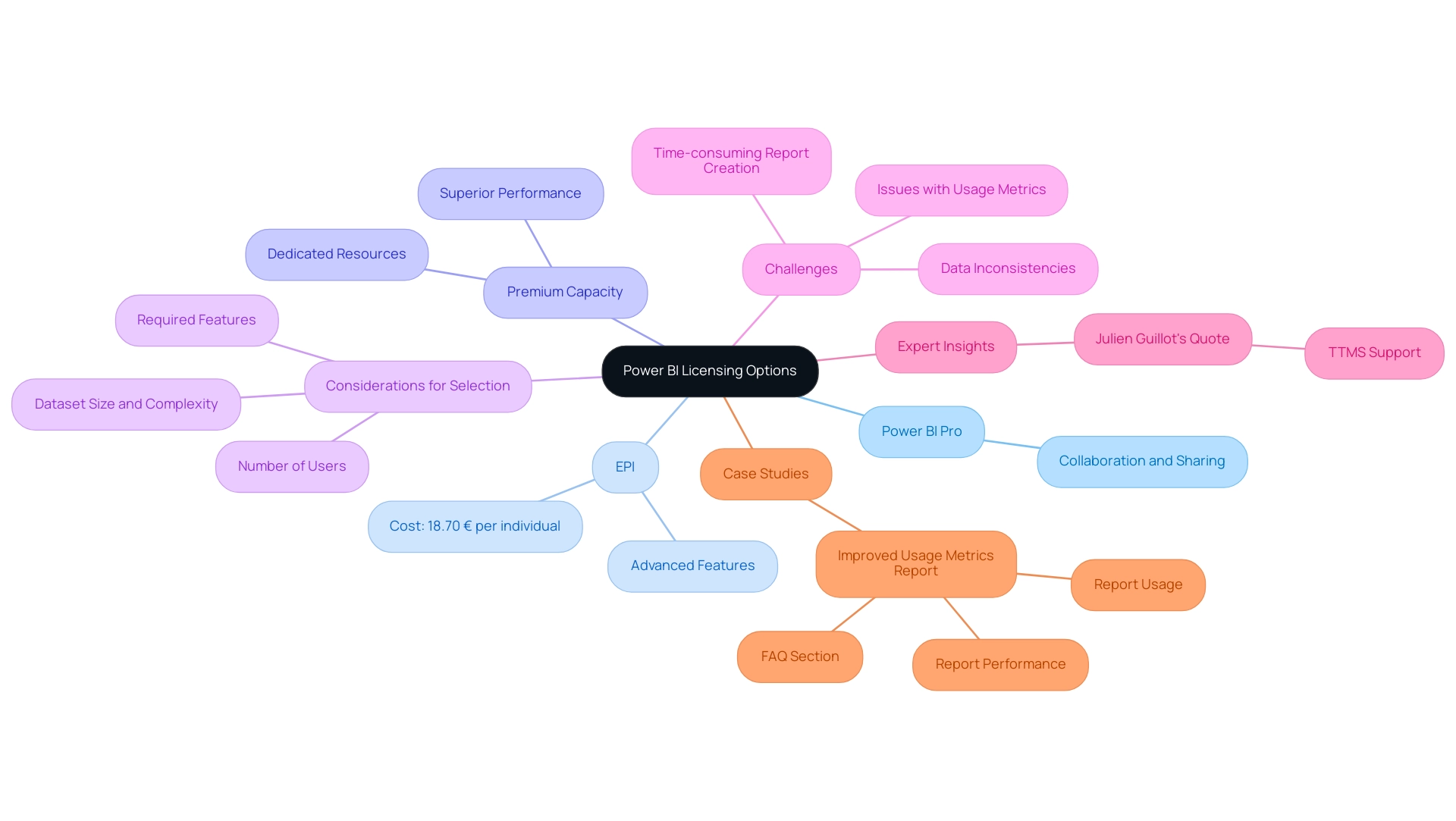
The Impact of Microsoft Fabric on Power BI Premium Users
Microsoft Fabric serves as a transformative platform that greatly enhances the functionality of premium capacity Power BI clients, especially in the areas of reporting and operational efficiency. Its key impacts are noteworthy:
-
Improved Data Integration: With Microsoft Fabric, users experience seamless integration of diverse data sources, simplifying data preparation and enhancing overall efficiency. This improvement has been quantified, with business analysts reporting a 20% increase in access and output, contributing to potential savings of $4.8 million.
-
Enhanced Analytics: The platform enables individuals to utilize advanced analytics features that function seamlessly across the Microsoft ecosystem. This capability enhances analysis and drives informed decision-making, aligning with the need for actionable insights that lead to business growth.
-
Unified Experience: Microsoft Fabric offers an integrated experience across multiple Microsoft tools, enabling smoother management of workflows. This integration is crucial, especially given that 60% of organizations report being ill-prepared for AI-driven cyber threats. As Arish Siddiqui from Dynamics Square observes, “Reskilling and upskilling programs can assist individuals in adjusting to evolving job demands,” emphasizing the need for organizations to improve their information management strategies and utilize solutions like RPA to reduce risks.
To further improve information reporting and operational efficiency, individuals can utilize the 3-Day BI Sprint, which enables the rapid creation of professionally designed reports, and the General Management App that leverages premium capacity Power BI for comprehensive management and intelligent reviews. Additionally, incorporating Robotic Process Automation (RPA) can streamline workflows, reducing repetitive tasks and freeing up teams for more strategic work.
As BI users explore these enhancements, they can derive insights from case studies like ServiceNow Bonding, which highlights the importance of efficient information exchange in today’s fast-paced business environment. Users are encouraged to explore the frequently asked questions section regarding BI and Microsoft Fabric to maximize their platform usage and adapt effectively to upcoming features, ensuring they remain at the forefront of integration advancements. Furthermore, engaging in GenAI Workshops and utilizing Small Language Models can further enhance the effectiveness of AI solutions in driving operational efficiency.
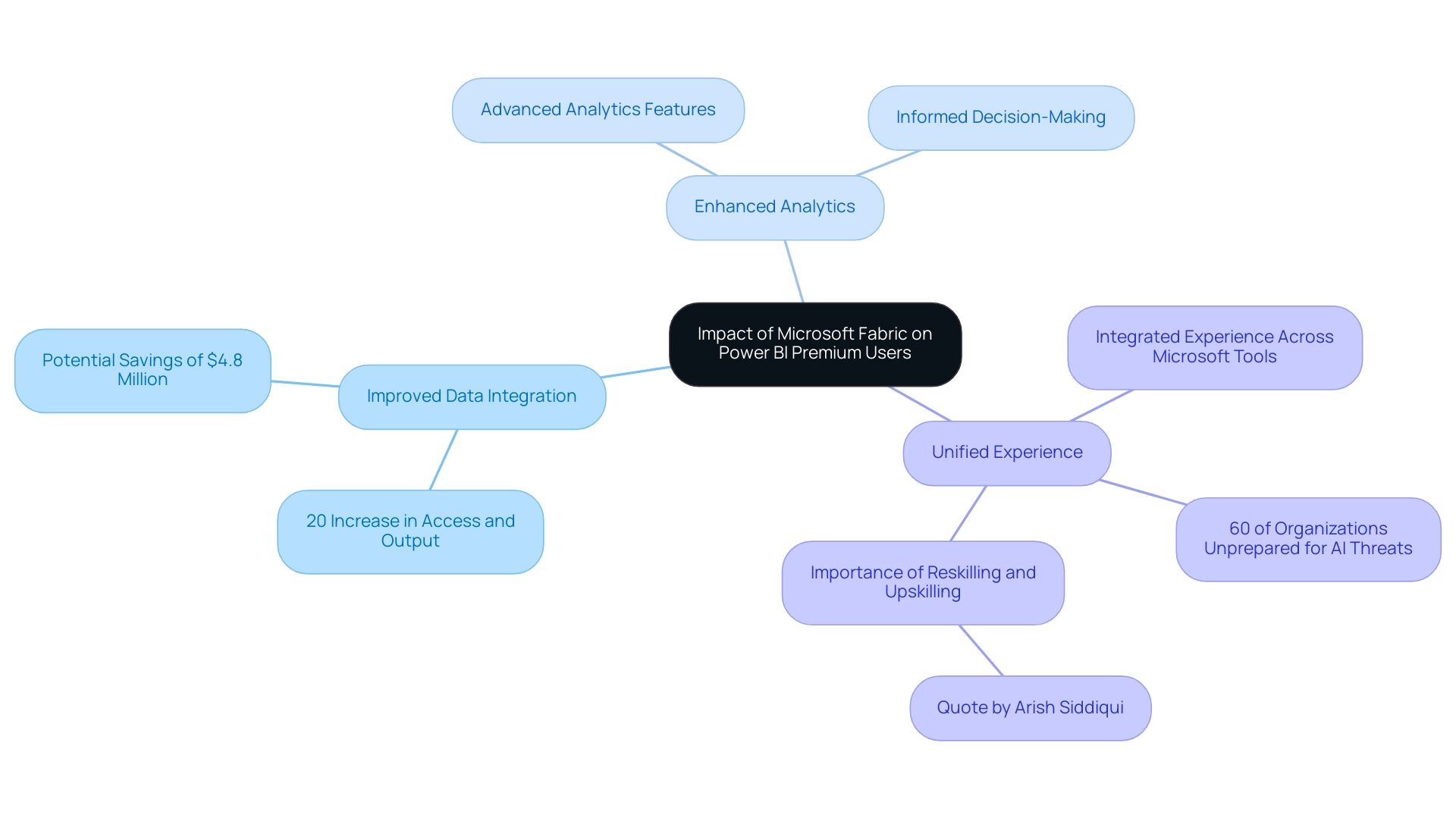
Preparing for the Future: What to Expect After Transitioning to Power BI Premium
Following the transition to Power BI Premium, organizations must focus on several crucial areas to maximize their investment:
-
New Features: Regular updates will unveil innovative functionalities that significantly enhance analytics capabilities. For instance, the introduction of color-coded Sales Velocity charts enables individuals to quickly assess profit levels—green indicating high profit, yellow for moderate, and red for low profit. This visual representation assists in making informed decisions quickly, countering the common challenge of information overload encountered during report creation.
-
Renaming Metrics: Existing scorecard metrics will be renamed to Goals, maintaining their functionality while clarifying the transition process for individuals, and addressing potential confusion arising from inconsistencies in information reporting.
-
Training Needs: As staff acclimate to new tools and processes, continuous learning will be pivotal. Evaluating the training requirements of BI Premium participants will guarantee that your team stays prepared to make the most of the platform’s full potential. Saveen Reddy, Director of Community & Learning at Microsoft Fabric, notes that these tools are perfect for illustrating the proportion of individual series to the whole and how they evolve over time, emphasizing the need for comprehensive training to provide actionable guidance to stakeholders.
-
Performance Monitoring: Establishing metrics to track the effectiveness of the transition is vital. Tracking usage metrics and participant engagement can assist in pinpointing areas for additional improvement, ensuring that the organization is on the correct path to attaining operational efficiency while reducing the risk of inconsistencies. A strong governance strategy is crucial to uphold information integrity and trust across reports.
-
Copilot Summaries: Users can now subscribe to Copilot summaries for BI reports, allowing them to receive insights via email. This feature enhances user engagement and keeps teams informed about key trends, directly addressing the challenge of extracting insights from reports.
-
Case Study: A practical example of effective information management post-transition is illustrated by a new tool that allows users to quickly remove unused sources from their app via a broom icon in the tab. This feature simplifies app management and ensures that only relevant information is retained, promoting clarity and trust in the presented content.
By adopting a proactive stance and being well-prepared for these elements, organizations can fully harness the capabilities of Power BI Premium, fostering continuous improvement in their operational processes and transforming challenges into opportunities for growth. The General Management App plays a critical role in providing actionable guidance, ensuring stakeholders can make informed decisions based on reliable data.
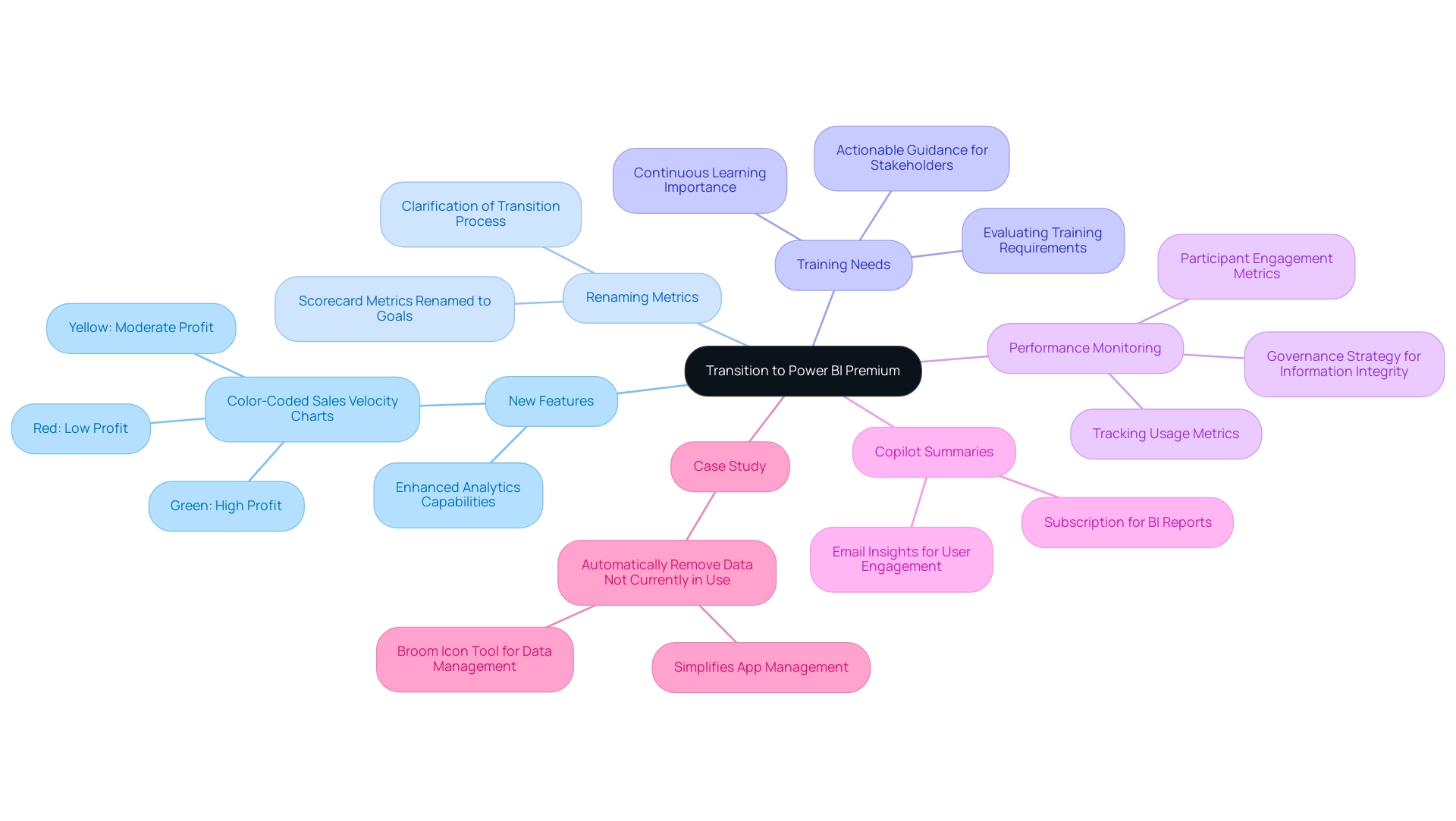
Conclusion
Transitioning to Power BI Premium offers organizations a significant opportunity to elevate their data analytics capabilities and streamline reporting processes. By leveraging its advanced features, such as enhanced performance, larger data capacity, and integrated AI functionalities, businesses can overcome common challenges like data inconsistencies and time-consuming report creation. The step-by-step guide provided ensures a seamless migration, empowering teams to maximize the potential of this powerful platform.
Selecting the right licensing option is crucial for aligning with organizational needs, whether opting for Power BI Pro, Premium Per User, or Premium Capacity. Understanding the impact of Microsoft Fabric further enhances the user experience, enabling improved data integration and advanced analytics that drive informed decision-making. As organizations prepare for the future, they must focus on continuous learning, performance monitoring, and embracing new features to fully capitalize on their investment.
Ultimately, embracing Power BI Premium not only transforms data management but also empowers teams to derive actionable insights that can drive strategic growth. By fostering a culture of data-driven decision-making, organizations can navigate the complexities of today’s business landscape with confidence, turning challenges into opportunities for innovation and efficiency.

